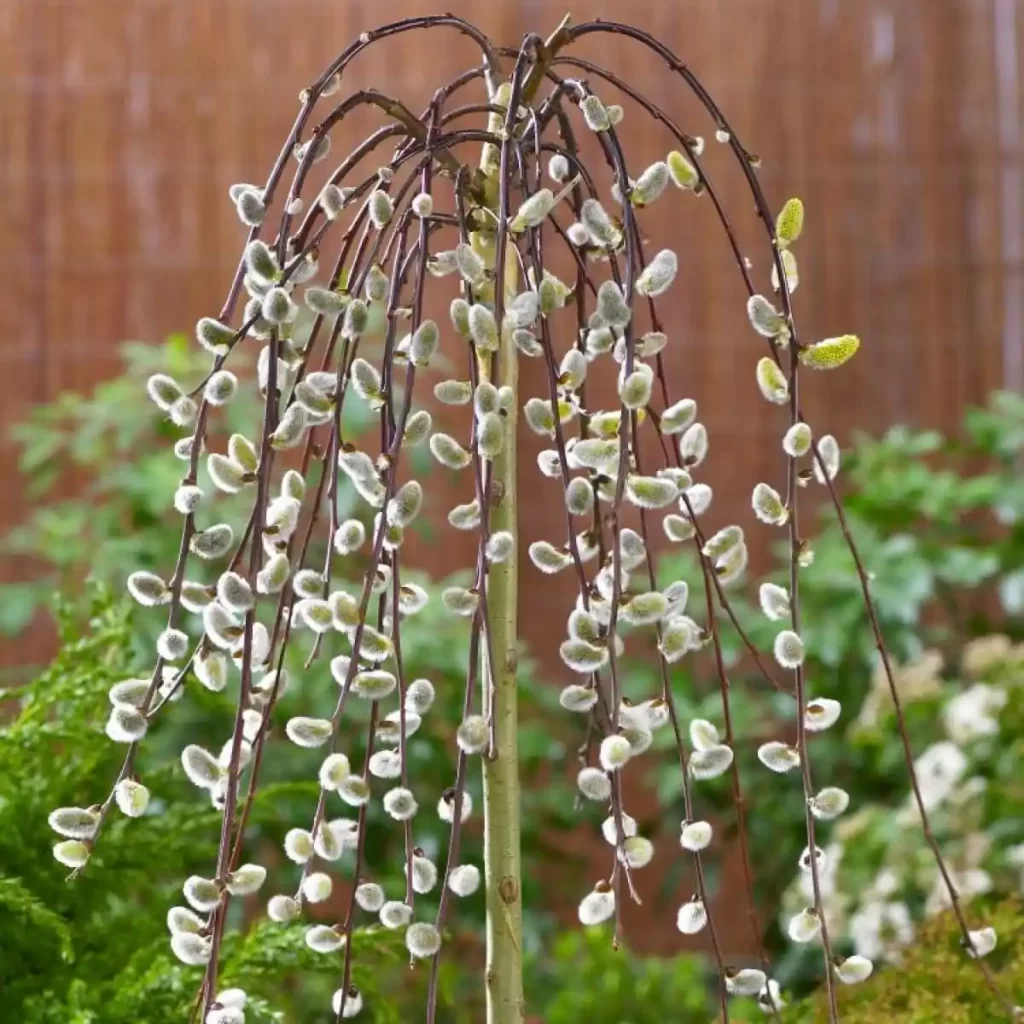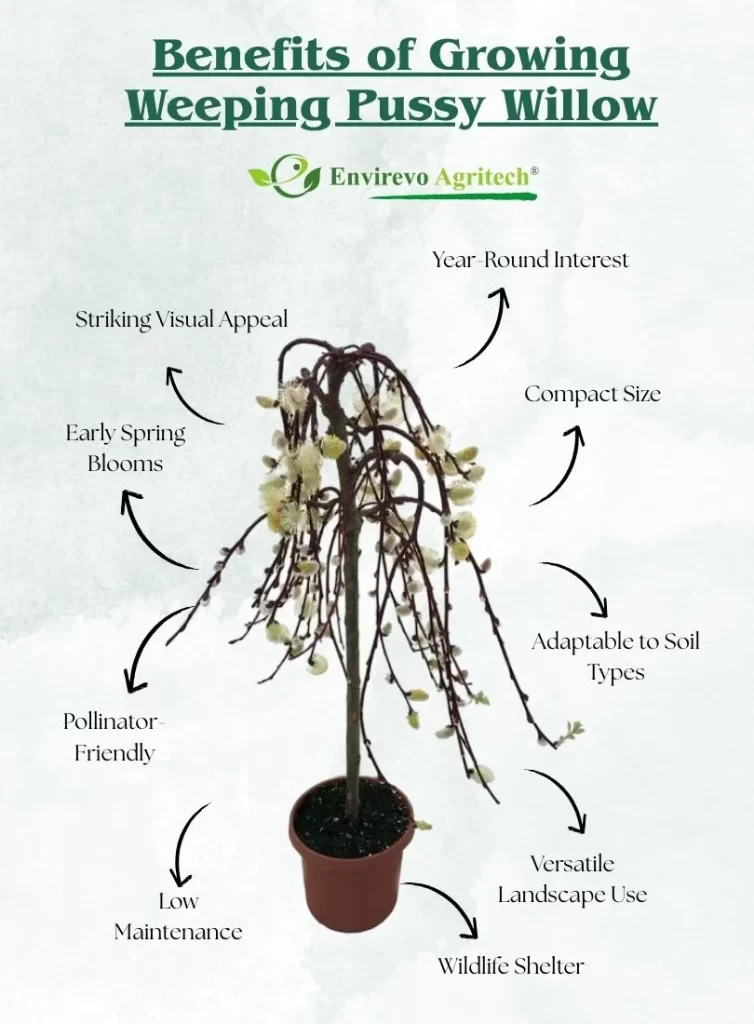Table of Contents
The Weeping Pussy Willow (Salix caprea ‘Pendula’) is more than just a picturesque tree — it’s a statement of elegance and charm in any garden. With its cascading branches, silver catkins, and whimsical appearance, it transforms bland landscapes into enchanting garden spots. In this comprehensive guide, we delve deep into everything you need to know about planting, caring for, and understanding why the Weeping Pussy Willow has captured the hearts of gardeners worldwide.
What is a Weeping Pussy Willow?
Botanical Overview
The Weeping Pussy Willow is a cultivar of Salix caprea, commonly known as the Goat Willow or European Pussy Willow. What sets this particular variety apart is its pendulous, weeping branches that flow down like a waterfall, making it a centerpiece in many ornamental gardens. It typically grows to a height and width of 6 to 10 feet, depending on pruning and training methods.
This tree is deciduous and is cherished for its soft, furry catkins that appear in early spring before the leaves unfold. These silver-gray catkins, often tinged with a hint of pink, are a vital early pollen source for bees, making the tree not only beautiful but ecologically beneficial.

Aesthetic Appeal and Garden Use
Its graceful, weeping habit makes it ideal as a focal point in garden landscapes. Whether planted near water features, patios, or as a standalone feature on a lawn, the tree adds architectural interest throughout the year. Its dramatic form contrasts beautifully with upright or bushy companion plants, offering year-round texture and movement to the garden design.
| Attribute | Details |
|---|---|
| Common Name | Weeping Pussy Willow |
| Botanical Name | Salix caprea ‘Pendula’ |
| Plant Type | Deciduous ornamental tree |
| Hardiness Zones | USDA Zones 4 to 8 |
| Mature Height | 6 to 10 feet (can vary with pruning) |
| Mature Spread | 6 to 10 feet |
| Sun Exposure | Full sun to partial shade |
| Soil Type | Moist, well-drained; adaptable to various soil types |
| Soil pH | Acidic to neutral (5.5–7.0) |
| Bloom Time | Early spring (before leaves appear) |
| Flower Color | Silvery-gray catkins, sometimes tinged with pink |
| Special Features | Weeping form, wildlife-friendly, early-season pollinator |
Why Everyone Wants a Weeping Pussy Willow
- Striking Visual Appeal: Its cascading, weeping branches and soft catkins add a unique, ornamental charm to any landscape.
- Early Spring Blooms: One of the first trees to bloom, providing interest and color in late winter to early spring when few other plants are active.
- Pollinator-Friendly: The fluffy catkins offer an early source of pollen for bees and other beneficial insects, supporting local ecosystems.
- Low Maintenance: Once established, the tree requires minimal care — just occasional pruning and consistent watering.
- Versatile Landscape Use: Suitable for a variety of garden styles — from formal gardens and cottage landscapes to water features and container plantings.
- Adaptable to Soil Types: Tolerates clay, loam, and sandy soils, as long as moisture is consistent.
- Compact Size: Ideal for small gardens or urban yards, as it generally grows to a manageable size (6–10 feet).
- Year-Round Interest: Even without leaves, the weeping form offers dramatic structure and beauty in winter.
- Wildlife Shelter: Its dense canopy provides excellent cover and nesting opportunities for birds.

Planting the Weeping Pussy Willow
Best Time to Plant
The ideal seasons to plant a Weeping Pussy Willow are spring and early autumn. These seasons offer moderate temperatures and sufficient rainfall, allowing the root system to establish before the tree faces extreme weather conditions.
Selecting the Right Site
Sunlight
This tree thrives in full sun to partial shade, ideally receiving at least 6 hours of direct sunlight daily. Full sun exposure promotes more prolific flowering and healthier foliage.
Soil Conditions
The Weeping Pussy Willow prefers moist, well-drained soils but is highly adaptable. It tolerates a wide range of soil types, including clay, loam, and sandy soils. However, consistent moisture is key, particularly in hot or dry climates. Avoid waterlogged conditions, as these can lead to root rot.
Spacing and Location
Because of its vigorous roots and wide-spreading branches, it’s best to plant it at least 15 feet away from buildings, pathways, or underground utilities. If planting multiple willows, maintain spacing of 10 to 15 feet to prevent overcrowding and ensure optimal air circulation.
Planting Instructions
- Dig a hole twice as wide and deep as the tree’s root ball.
- Loosen the soil at the bottom to help roots spread easily.
- Place the tree in the hole, ensuring the crown (where trunk meets roots) is level with the ground.
- Backfill the hole with a mix of native soil and compost.
- Water thoroughly to eliminate air pockets and settle the soil.
- Apply mulch around the base, keeping it 2-3 inches away from the trunk to prevent rot.
Weeping Pussy Willow Care: Your Complete Guide
Watering Needs
Proper watering is the cornerstone of Weeping Pussy Willow care. While the tree is relatively drought-tolerant once established, it performs best in consistently moist soil. During its first growing season, water deeply once or twice a week depending on rainfall and soil type. In hot, dry climates, increase watering frequency.
Mature trees generally need weekly watering, especially in periods of drought. Use a soaker hose or drip irrigation to maintain even soil moisture, which prevents stress and promotes lush growth.
Fertilizing
Feed your tree in early spring just before new growth begins. Use a balanced slow-release fertilizer or organic compost to enrich the soil. A 10-10-10 NPK formula is typically sufficient. Avoid high-nitrogen fertilizers as they encourage excessive leafy growth at the expense of flowers and catkins.
Mulching
Mulching conserves soil moisture and regulates soil temperature. Use 2 to 3 inches of organic mulch such as bark chips or shredded leaves. Replenish mulch annually to suppress weeds and support the tree’s shallow root system.
Winter Protection
While hardy in USDA zones 4 to 8, younger trees benefit from extra winter care. Apply a thicker layer of mulch in late fall to insulate roots. Wrap young trunks with tree guards to prevent frost cracks and rodent damage.
Pruning Weeping Pussy Willow
Pruning is essential to maintain the graceful form and overall health of your Weeping Pussy Willow. Left unpruned, the branches can become tangled or overgrown, diminishing the plant’s natural elegance.
Best Time to Prune
Late winter or early spring, just before new growth begins, is the ideal time for pruning. This timing allows you to shape the plant before buds emerge, minimizing stress on the tree.
How to Prune?
- Use clean, sharp pruning shears or loppers.
- Remove any suckers growing from the base or trunk.
- Cut away crossing or rubbing branches to improve airflow.
- Trim the long, trailing branches to maintain a symmetrical, balanced form.
- Avoid cutting into the main trunk unless necessary—focus on shaping the outer canopy.
For shaping, maintain the umbrella-like canopy by trimming back long, stray branches. You can also train young trees using staking and tying methods to achieve a symmetrical, arched form. Proper pruning not only enhances the plant’s beauty but also extends its lifespan, making your Weeping Pussy Willow a long-term centerpiece in your garden.
Container Growing: A Versatile Option
Weeping Pussy Willows can be grown in large containers, making them perfect for patios, decks, or small gardens. Use a pot at least 18 inches wide with good drainage. Container plants require more frequent watering and annual root pruning or repotting to prevent root-bound conditions.
Fertilize container-grown trees monthly during the growing season and protect from freezing temperatures by overwintering in sheltered areas or wrapping pots with insulating materials.
Propagating Weeping Pussy Willow Plants
Propagating a Weeping Pussy Willow is relatively simple and cost-effective, making it a popular choice for gardeners who want to expand their collection or share with friends. The most common method is propagation through hardwood cuttings, which is both effective and beginner-friendly.
✔ Best Time to Propagate
The ideal time to propagate Weeping Pussy Willow is during the late winter to early spring, when the tree is still dormant but just about to break bud. This timing ensures high rooting success before the growing season begins.
✔ Propagation Steps (Hardwood Cuttings)
- Select a Healthy Stem: Choose a firm, pencil-thick stem that is at least 6–10 inches long and has several leaf nodes.
- Make the Cut: Using clean, sharp pruners, cut the stem at a 45° angle just below a node.
- Remove Lower Leaves: Strip off any leaves or buds from the lower half of the cutting.
- Dip in Rooting Hormone (optional but recommended): This increases the chances of successful root development.
- Plant in Soil: Insert the cutting into a pot filled with moist, well-draining soil or directly into a prepared garden bed. Ensure at least two nodes are buried.
- Water and Cover: Water the soil and cover the cutting with a plastic bag or humidity dome to retain moisture.
- Place in Bright, Indirect Light: Avoid direct sunlight until roots are established (usually 4–6 weeks).

✔ Water Propagation Option
Alternatively, Weeping Pussy Willow cuttings can also root in a jar of water. Simply place the cutting in a clean jar, change the water every few days, and wait for roots to appear before transplanting into soil.
✔ Aftercare
Once roots have developed (typically 4–8 weeks), transplant the cutting into a larger container or directly into the garden. Keep the soil moist and gradually acclimate the plant to outdoor conditions if it was rooted indoors.
Common Issues and Troubleshooting
| Issue | Symptoms | Cause |
|---|---|---|
| Aphids | Curled leaves, sticky residue (honeydew), stunted growth | Sap-sucking insects |
| Scale Insects | Bumpy white or brown lumps on stems, yellowing leaves | Sucking pests |
| Caterpillars | Chewed or ragged foliage, presence of frass (droppings) | Moth or butterfly larvae |
| Willow Scab (fungus) | Olive-brown blotches on leaves, premature leaf drop | Fungal infection |
| Black Canker (fungus) | Black lesions on branches and stems, wilting, dieback | Fungal disease |
| Rust | Orange powdery spots on underside of leaves | Fungal spores |
| Root Rot | Wilting, yellowing leaves, mushy roots, plant decline | Poor drainage, overwatering |
| Powdery Mildew | White, powdery coating on leaves and stems | Fungal spores in humid conditions |
| Borer Insects | Tunnels in branches, oozing sap, branch dieback | Larvae of beetles/moths |
Conclusion
The Weeping Pussy Willow isn’t just a tree — it’s a living sculpture that elevates the beauty and biodiversity of any landscape. With proper planting, attentive care, and strategic placement, it can become a signature feature in your garden. Whether you’re a seasoned horticulturist or a new homeowner dreaming of a fairy-tale yard, the Weeping Pussy Willow is a choice you won’t regret.
Embrace the elegance, enjoy the blooms, and let this graceful weeper bring year-round charm to your outdoor space.








